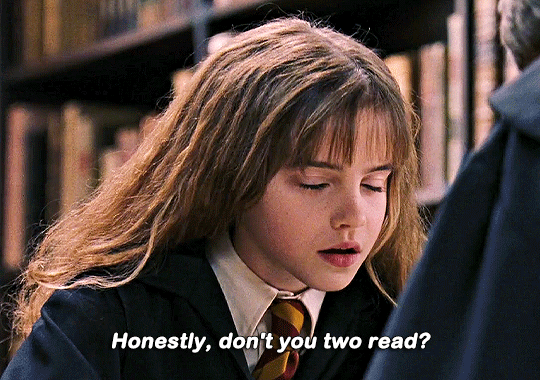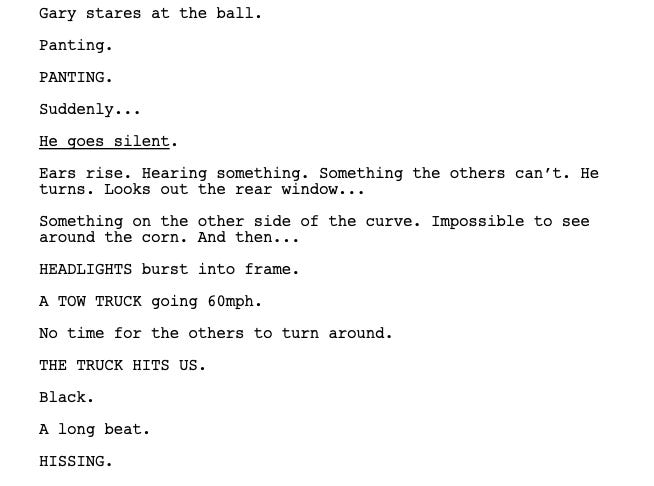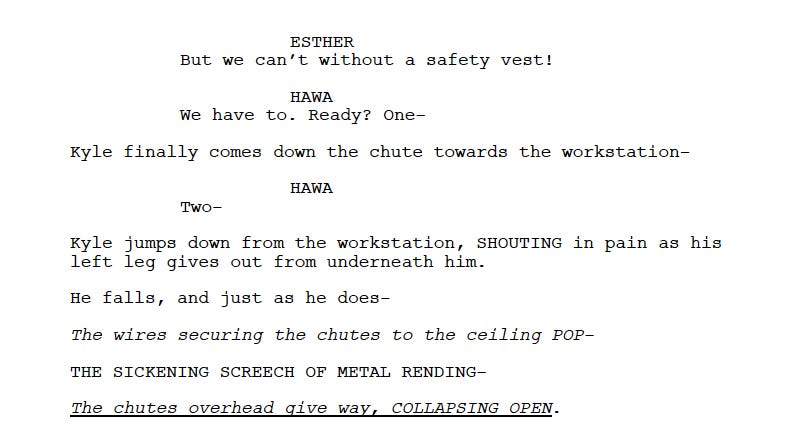No one reads anymore
I don’t know when it was decided that people no longer read.
But all of a sudden, it was all any screenwriter could complain about — “Nobody reads anymore!”
Not emails, not party invites, and certainly not Substack newsletters (thank you for being here!).
My reps tell me that back in the day, a screenwriter could write a spec script, send it out to town, and know within a week or two whether or not it was going to sell.
These days, you’d be hard pressed to get a response within 4-6 weeks.
To be fair to executives, their to-read piles are unmanageably long, and their stacks grow by the minute.
To adjust to this trend, I wanted to point out an interesting phenomenon I’ve noticed within the last year.
How it started …
Traditionally, action description in a script is clumped together. It’s advised that one should leave more white space than not, but when a lot is happening, it’s inevitable that whole paragraphs of text will describe character movements.
Eric Roth, a legendary screenwriter known for Forrest Gump, Munich, The Curious Case of Benjamin Button and many more, is 79-years old and still working (#goals). He would be what you’d call “old school.”
Here is the introduction of Leonardo DiCaprio’s character in Killers of the Flower Moon (2022), written by Roth and Martin Scorsese:
A hell of a lot is going on, and notice the way the paragraph is chunked together as Ernest takes in the train depot.
Perhaps the most egregious example of this style of chunking in recent memory can be found in Todd Field’s Tar (2022):
I remember the first time I saw this enormous paragraph, I balked. This was so difficult for me to parse that I gave up reading this screenplay after the first page.
How it’s shifted …
The Black List is an annual list of the town’s “best unproduced screenplays,” as voted on by Hollywood executives. It’s a pretty good indication of how up-and-coming writers are plying their craft these days. I spent much of 2024 reading through the scripts of my fellow peers, and I noticed something interesting.
No one chunks anymore.
Take a look at Bad Boy by Travis Braun, the script that topped the 2023 Black List. The story is a psychological thriller told from the point of view of a dog, who suspects that his new owner is a serial killer.
Here’s an example of Braun’s action description:
Notice the way the action moves down the page, leaving plenty of negative white space. No description exceeds more than two lines.
Here is an early moment from Head Games by Colin Liddle, a Black List script that has since seen attachments from Henry Golding and Samuel L. Jackson:
This style that we see from Braun and Liddle is a marked move away from the chunking of previous generations, as exhibited by the likes of Roth and Scorsese and the extreme of Field. Thus …
We are in the era of the staccato one-liner.
Perhaps the most extreme version of this can be found in Evan Twohy’s work. I had the honor of meeting Twohy at the Black List dinner last year, and he’ll be the first one to tell you that his work is unconventional.
His writing style is distinctive, almost poetic. Here’s a snapshot from his Black List script Roses:
So why are we writing like this?
I posit that this style we’re currently seeing among industry contemporaries is in direct reaction to the idea that “nobody reads anymore.”
Writers have adapted to make their action descriptions flow, to get your eyes moving down the page as quickly as possible.
Even the way I’m writing this newsletter is following that sort of staccato flow.
Obviously, not EVERYONE is doing this, but it’s interesting to observe this stylization occurring throughout a number of Black List scripts.
How it’s affected my own writing
I’ll admit that the staccato one-liner has crept into my own scripts, and not intentionally.
This is a snapshot from UNNIE, my 2023 Black List script. Here’s how the cold open reads:
The core of the “kill” sequence is told in chunked grafs. (For context, this script went out to town in March of 2023).
By contrast, here’s a snapshot of The Working Dead, my zombie movie set at an Amazon fulfillment center. This script went out to town in March of 2024:
Voila! Whether I intended to or not, I’ve adopted the staccato one-liner.
Which way is better?
The nice thing about screenwriting is there is no “right way” to go about action description. Obviously try not to go full Todd Field on the page, but you don’t necessarily have to deploy the staccato one-liner that seems to be the trend right now.
In fact, I’ll let you decide. In comparing the two scenes from my scripts above, which action sequence is more engaging?
I personally think that with the way our brains are currently short-circuited, the staccato one-liner does make an easier read, but you can still write an excellent script with chunked grafs.
If the staccato one-liner doesn’t feel natural to you, don’t incorporate it!
For all you writers out there, let me know in the comments below what you think about the way our truncated writing seems to be adapting to the times.
And if you’re not in the industry, I hope you found this a fascinating look at one of the many calculations a screenwriter makes as they go through their process.
The goal of this newsletter is to continue analyzing these types of craft topics and industry trends, specifically from a screenwriting lens. I hope you consider subscribing and joining the discussion! And remember, at least in today’s day and age …















Ok this is *fascinating* because I write for kids and something that has become extremely popular recently in the world of middle grade lit is the novel in verse which is exactly this. Short lines, lots of white space, turn pages quicker. So interesting to know that it isn't just kids that are struggling to read long blocks of text, it's Hollywood executives, too.